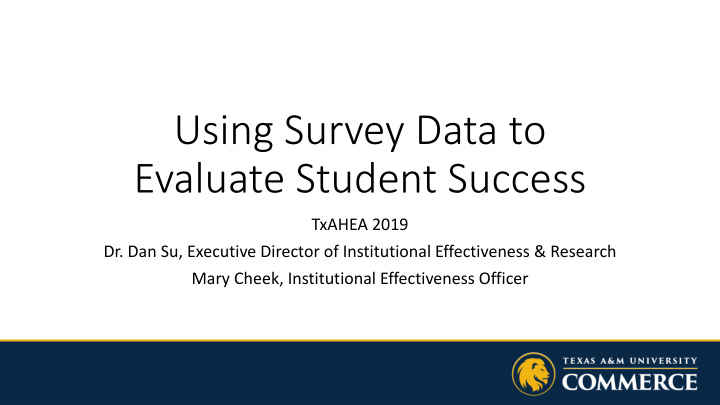



Using Survey Data to Evaluate Student Success TxAHEA 2019 Dr. Dan Su, Executive Director of Institutional Effectiveness & Research Mary Cheek, Institutional Effectiveness Officer
Assessing student success Use results Define to seek outcomes improvements Measure
Defining student success • Retention/Persistence • Self-efficacy • Completion • Self-awareness • Academic Achievement and • Engagement Learning Outcomes • Resilience • Employability/Placement • Debt Load
Student Satisfaction Graduation Alumni Survey Inventory Exit Survey
SSI Survey Highlights SSI—three weeks achieved nearly 30% response rate • 0 survey incentive budget with diverse and rich incentives • Full engagement of colleges and departments • Diligent communication with students, timely distribution of incentives • Representative data for further utilization to inform changes
Obstacles to student success The instruction in my major Tuition paid is a worthwhile I am able to register for field is excellent investment classes I need with few conflicts Faculty provide timely Adequate financial aid is feedback about student available for most students progress in a course Learning outcomes Persistence/Completion Debt Load
GES Survey highlight • GES—highest response rate • Rich data- academic, service, experiences • Indirect measure of a list of comprehensive marketable skills • Pre- graduation employment information • Students group contribute to completion success
Undergraduate Student
Graduate Student
Alumni Survey Highlight • Run once a year, (N=2700), 15% response rate • Overall positive information that proves TAMUC degree promote social upward mobility • Provide reasonable first-gen percentage • Post-graduation employment information (salary, filed of employment, position, etc…)
Alumni Survey--Loan and Debt Status 2019 Texas Public Higher Education Almanac • 38% graduate with $0 debt • Student with debt 65% (35% without debt) • Average debt $27,000 • Average student debt $29,879 Percentage graduating without loans: • • 35% undergraduate Parent debt portion $2,667 • 40% graduate 13
Alumni Primary Activity: Graduate Standard Reporting for NACE Undergrad Employed, or not Seeking Employment (%) 96% 95% 90 85 80 70 72 60 50 40 30 20 10 13 3 4 4 3 3 1 0 0 1 1 1 4 5 0 Employed Full Employed Part- Employed, Continuing Military Service Volunteer Not employed, not Not employed, time time Multiple Jobs Education seeking seeking Grad Undergrad
Are America’s colleges promoting social mobility? Stories of upward mobility were once a key feature of American life. Children born in the 1940s were almost guaranteed to grow up and earn more than their parents did. “By the time you get to when I was born in 1980, only 50 percent of kids earn more than their parents do”-John Friedman (Brown University economist) https://hechingerreport.org/are-americas-colleges-promoting-social-mobility/
A question asked alumni to compare me today to my family when I started college.
Did TAMUC degrees help students’ upward social mobility? *Results produced by utilizing Paired-Samples T Test, p= .000 for all the comparison. Breakdown Me, today My family Significantly better? Overall (N=981) 3.41 3 YES! Graduate Students (N= 557) 3.66 3.07 YES! Undergrad Students (N=424) 3.08 2.94 YES! Non-FirstGen (N=488) 3.35 3.21 YES! FirstGen (N= 493) 3.47 2.81 YES!
Breakdown Me, today My family Significantly better? Class of 2013 (N=312) 3.67 3 Class of 2016 (N=319) 3.38 2.99 Class of 2017 (N= 350) 3.21 3.04 Female (N=527) 3.24 2.91 Male (N=417) 3.65 3.15 • Income range mode: Female $40,000-59,999; Male $60,000-79,999 • *Results produced by utilizing Paired-Samples T Test, p= .000 for all the comparison. Higher e educ ducation c can be n be pa part of i improving ing bo both h economic o opp pportuni nity a and s nd social stabi bilit lity i in n out ut coun untry. Wha hat de determines SMI: I: low tui uitio ion, , recruit it m more e economicall lly di disadvantaged s d stude udents, a and nd ens nsure t tha hat enr nrolle led d stude udents g grada date into g good pa paying j jobs. The he r results s strong ngly ly sug uggest tha hat T TAMUC pr promotes our ur graduates’ ’ social m l mobil bility up upwardly ly.
Student Success
Questions? Dan.Su@tamuc.edu Mary.Cheek@tamuc.edu
Recommend
More recommend